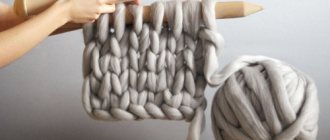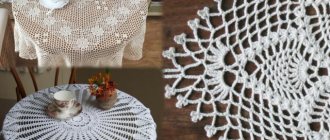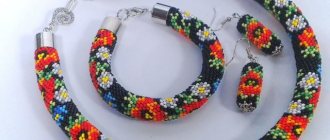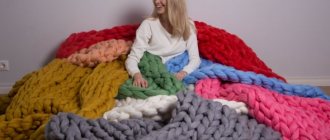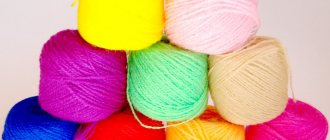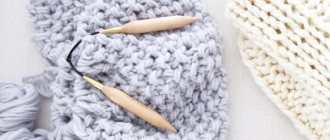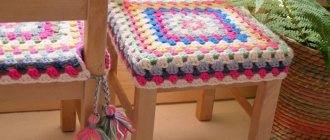Real needlewomen will not throw away a single thread left after knitting, but will carefully put them in a bag or box to create a knitted masterpiece from leftover yarn in the future.
Can you crochet? Publish your work on kru4ok.ru
From these remaining balls you can knit not only decorative items with pompoms, but also a full-fledged original piece of clothing. You just need to use your imagination, then the multi-colored mosaic will definitely come together successfully.
Features of knitting with different threads
Over time, needlewomen collect remnants of yarn of different texture, thickness and color. Based on the available variety, you need to think about how best to combine the yarn. In some products you can combine cotton and acrylic, mohair and melange, in others it is better to choose threads of the same texture.
The thickness of the yarn can also be combined, alternating thick and thin thread, or knit the middle part of the product with yarn of one thickness, and the edges with another.
Along with the thickness of the thread, you can change the knitting pattern. If you need to get yarn of the same thickness, then thinner threads are taken in 2 - 3 folds. The number of knitting needles or hooks is selected according to the thickness.
Products are knitted in one piece or in separate fragments, which are then joined together. If you use yarn with knots and bumps, then it is better to knit with stockinette or garter stitch and do not use patterns.
Crocheting and knitting from leftover yarn allows you to create interesting and practical things
You can also experiment with color by knitting individual fragments of the pattern or details of the product with yarn of different shades. Contrasting colors look more impressive in the finished item. To prevent the product from being too colorful, you can choose a base color and 2 - 3 shades of leftover yarn.
Decorative textiles
Many craftswomen love to decorate their home with knitted capes, blankets, pillows and other decorative textiles. It can be knitted either from plain yarn or from its remnants. In the latter case, the most suitable option would be to create striped products in which the variety of colors is not particularly important. If you have a large number of small skeins of yarn in your boxes, you can use them to make large blankets and capes using the granny square technique.
. How are such masterpieces created?
- Using threads of the same thickness, knit small squares using a crochet hook. Select a pattern for this based on personal preferences and your skill level.
- Colors and patterns must be selected before work begins. Don't forget that the first rows require less yarn than the last ones, so you should start knitting a square with the least amount of threads available.
- The next stage is that the finished squares are sewn together with a needle or crocheted. In the latter case, you can use threads that match the squares or contrasting yarn.
In order to create an original accessory from the remaining yarn, it is not at all necessary to pick up a hook and knitting needles. A fashionable trend in recent years is the manufacture of runners and rugs from pompoms.
. You can make soft blanks yourself.
Preparing the balls
When preparing yarn, you need not only to decide on the thickness and color scheme, but also pay attention to the structure of the threads. If a used product has been unraveled, the yarn will be wavy. Knitting from such material is not very convenient, and the result may be an uneven fabric.
To straighten the yarn, it needs to be steamed in a water bath.
To straighten the yarn, you need to steam it (heat water and hold the yarn over steam) or wash and dry it. Before processing, the yarn is unwound, using, for example, the legs of a stool, and then wound back into balls.
The “folk” way to steam yarn is to place the ball in a container and pull the thread through the inverted lid of a pan of boiling water. Slowly wind the thread into a ball.
Interesting ideas, patterns for crocheting and knitting for home from leftover yarn
Knitting patterns for any product from leftover yarn allows you, by showing imagination and a creative approach, to obtain original items.
This:
- products for the home: pillows, rugs, covers, blankets, panels;
- little things for the kitchen: coasters, potholders, napkins, tablecloths;
- souvenirs: toys, baskets, pencil holders, bookmarks;
- clothing and jewelry.
The following notations are used in circuit descriptions:
| Hook | |
| PP | lifting loop |
| VP | air loop |
| st.b/n | single crochet |
| senior s/n | double crochet |
| st.s/2n | double crochet stitch |
| Spokes | |
| LP | facial |
| IP | purl |
| nak. | yarn over |
The description enclosed in ** is repeated.
Photo gallery of beautiful multi-colored blankets for the bedroom or living room, knitted from leftover yarn:
PreviousTextilesStandard sizes of kitchen towels
Next
TextilesHow to crochet a gorgeous floral blanket: a detailed description of the pattern and technique
Rugs
The simplest product made from leftover yarn is a rug. It can be knitted into a single fabric of any shape: rectangular, square, round, or assembled from several identical fragments, which are then connected to each other with a needle or hook. Multi-colored fragments can be square, triangular or diamond-shaped, knitted with a simple pattern, for example, purl stitch.
Bath mat
Crochet multi-colored squares from wool blend yarn. Dial the desired number of VP chains and 2 PP. Alternately knit a row of double stitches and a row of elongated loops.
Tie each of the squares with 2 rows of double stitches and combine them into one fabric. You can also tie the entire rug. For tying: 3 VP, 2 treble s/n in one loop and a connecting post in the third loop of the previous row.
Simple rectangular rug
From the remnants of yarn, selected according to thickness, from VP, knit chains, which are connected as you knit, or sew and wind into balls. The rug is knitted with knit stitches on thick knitting needles. After finishing the work, crochet the resulting product.
How to make rugs non-slip
Knitted rugs can be placed in any room, on the balcony or near your pet. They help create comfort and last a long time. The disadvantage of knitted rugs is that they slide on the floor.
To prevent the mat from slipping, it must be knitted on a special rubberized mesh
To eliminate this quality, you can purchase a special rubberized anti-slip mesh. It is cut to sizes slightly smaller than the rug and not glued. In this case, the rug is washed separately from the base. You can also crochet directly along the warp, pulling the thread through the holes. Then you will have to wash the product along with the base.
Blankets
Knitting a blanket pattern from leftover yarn will not be difficult, since a variety of patterns are suitable for a blanket: squares, zigzags, satin stitch, braids. An original patchwork plaid in patchwork style can be created by crocheting or knitting colored squares and joining or knitting them in a single fabric.
Plaid in squares
Description of the pattern for knitting a square with a side of 16 loops:
- Cast on 33 stitches (16 + 1 + 16).
- All loops are knit stitches.
- In the 2nd row and subsequent rows, knit 1 LP from the 3 central loops.
To knit another square, cast on 16 stitches and another 17 along the edge of the finished square. Knit similarly. Knit a row of squares to the desired width and proceed to the 2nd and subsequent rows of the blanket.
Zigzag plaid
Such a blanket is a great opportunity to go beyond the usual and create something special with your own hands, something more than, for example, an ordinary striped bedspread. Each color is used independently of the previous one, so you can use even tiny remnants of thread. In general, the project is really cool, cool and unusual. This blanket will truly brighten up your everyday life!
How to knit a blanket with a zigzag pattern - job description from gingerschatz
Potholders and coasters
Knitting patterns for pot holders or hot stands from leftover yarn is another idea for coziness and home decoration.
Crochet round potholders
Close the VP into a ring and cast 12 treble crochets into it, continue knitting in a spiral, knitting 2 treble crochets into each loop. Next, in turn, knit 2 treble s/n over 2 treble s/n, into other loops 1 treble s/n. Having knitted a potholder of the required size, make a loop for hanging the potholder - a chain is knitted from chain loops.
An example of tying for the edge of a potholder or a hot stand: *in the 2nd loop 2 treble s/n, 1 VP, 2 treble s/n; skipping the loop of the bottom row - 1 tbsp *. Having tied the larger half of the product, you can count the loops, and if they are missing, slightly change the location of the double crochets. The loop for hanging potholders can be evenly tied with single crochets.
Knitting potholders
Attractive potholders can be obtained by combining threads of different shades if you knit the squares with any pattern or satin stitch. It is better to choose the color to match the tone of the kitchen.
Clothes for dolls and toys
Grandmothers and mothers knitted clothes for our dolls, because in our childhood there were almost no Barbies (or they were very expensive). But you could knit different dresses, hats, and skirts for baby dolls yourself.
After all, all little princesses love to dress up their plastic girlfriends.
Use the leftover yarn to dress up your daughter’s favorite doll; such use will definitely be rational.
Cases
The remains of knitting threads are used to make furniture covers and other items.
Cover for stool
To crochet a stool cover, you need:
- Knit several strips from 1 row of VP and 2 rows of double stitch according to the size of the stool.
- On the narrow side of the strips, connect them with single crochets into 2 groups of the same number of strips.
- Assemble the resulting parts into one weave product.
Mobile phone case “Cat”
Crochet a chain of 20 chain stitches. 1 – 4th row: 19 st.b/n, 1 PP, turn. Then knit in the round in st.b/n. to the required size. Ears: 1 treble s/n., 3 treble s/2 n. in one loop, in the next loop 1 dc/3 n., 2 – 4 dc/n. in the arc, st.s./3 n.
Paws: close a chain of 3 VPs into a ring; knit 7 tbsp in the center of the ring; *st.b/n., 2 st.b/n in one loop*; knit in the circle with double stitches. Eyes: knit a chain of 18 chain stitches, knit double stitches, increase on the sides (2 double stitches in one loop), then decrease again (out of 2- uh st.b/n do 1).
Flower decorations
Knitting color schemes from leftover yarn allows you to create decorations for clothes or soft jewelry: beads, necklaces, bracelets and even earrings. By choosing the shades of the threads, you can knit a bouquet of a variety of flowers.
For jewelry, it is better to use thinner yarn.
Crochet flower
Crochet flower step by step:
- Connect 6 VP chains into a circle;
- make 3 PP and knit 24 treble stitches;
- knit 2 treble s/n in one loop, then 1 treble s/n, alternating until the end of the row;
- knit a row similar to the previous one;
- make petals: * skip 2 VP, knit 11 treble stitches/2 n in the 3rd, skip 2 VP and knit a treble stitch *, break the thread;
- from persons sides move to 2 p. and knit all st.b/n for the front loops;
- make the remaining petals similarly to the previous ones, but instead of 11 tbsp/2 n. knit 9.
There are many options for crocheting flowers, but a knitted flower looks no less attractive.
Knitting flower
To knit a petal, you need to cast on 8 stitches, remove the first one without knitting:
- On the 1st all LP.
- In the 2nd – IP.
- In 3 p.: *LP, nak.*.
- 4th row: IP.
- 5th row: LP.
- Repeat, alternating, the execution pattern of 4 and 5 p. to the desired height (this will be the middle of the petal).
- Then knit 2 LPs together, then all LPs, knit the last 3 loops: 2 LPs together, LP.
- Next R. 2 IPs together, then all IPs, last 3 sts: 2 IPs together, LP.
- Repeat decreasing until 3 stitches remain.
Simple flower step by step knitting Rose with leaves knitting
Tea rose step by step with knitting needles
Astra knitting step by step
- Close knitting according to the standard pattern.
- You need to make 6 petals, then fasten them together.
The middle of the flower can be decorated with a bead.
Earrings
To crochet earrings, you need to take the remains of any thin yarn. Cotton and viscose are suitable. There are many options.
Crochet earrings
To knit earrings, you need to buy a metal blank at a craft store. You can use blanks left over from old store-bought earrings.
Knit according to the pattern below.
Crochet earring pattern
Baskets
Leftover yarn can make an excellent basket, which will serve to store small items or become a souvenir and interior decoration. Baskets can be round, oval, square, with or without handles. It is better to do the work with crochet.
Square basket for storing small items
The entire basket is knitted with single crochets, the bottom is shaped like a square. The balls are joined into thick yarn using a No. 6 hook.
Square basket for storing small items: step-by-step knitting
Step by step:
- Knit a ring from VP and dc, 2 PP and fill the ring with 8 dc. Finish the row (like all subsequent rows) with a connecting loop into the lifting air loop.
- A square is knitted. 2 PP, 3 double stitches in one loop - an angle is formed. Between the corners 1 tbsp.
- 2 PP, 1 single stitch, corner (3 double stitches in one loop). 3 tbsp are knitted between the corners. from 3 sides. After the 4th corner, knit 1 treble stitch and a connecting loop into the lifting air loop.
- 2 PP, 2 sc.b/n, corner, *5 sc.b/n, corner*, repeat 2 sc.b/n.
- 2 PP, 3 st.b/n, corner, *7 st.b/n, corner*, 3 st.b/n.
- 2 PP, 4 sc.b/n, corner, *9 sc.b/n, corner*, 4 sc.b/n.
- 2 PP, 5 st.b/n, corner, *11 st.b/n, corner*, 5 st.b/n.
- 2 PP, 6 st.b/n, corner, *13 st.b/n, corner*, 6 st.b/n.
Depending on the thickness of the threads, you get a square with a side of 16 cm. Without increasing or decreasing, knit 1 row with single crochets, grabbing the back wall of the base loop. Knit the next 2 rows, forming the walls of the basket. You can use yarn in contrasting shades for them. You can tie a contrasting thread around the bottom and top of the basket.
Baskets of various shapes
If, while making additions evenly, you knit a round bottom with single crochets, you will get a round basket. Handles will be obtained if, when tying the top of the basket, leave the same number of VPs on both sides and tie the next row with DC.
To give the product a strict shape, metal and plastic parts are tied and connected : rings, triangles, squares, or frame wire is used as a base. This idea can be used for baskets, panels or toys.
Panel
Knitting a cross stitch pattern from leftover yarn results in a painting or panel that will decorate the interior or serve as a gift to family and friends.
Knitted pattern
According to the pattern, the number of loops equal to the number of squares is cast on the knitting needles. Stocking stitch is knitted. When changing color, the non-working thread is passed behind the fabric, from the wrong side. After completing the main work, the parts can be sheathed with a stem seam. Carefully steam the finished product from the inside out and place it in the frame.
The picture will be more interesting if you add three-dimensional details, such as flowers and leaves. Beads, beads, sequins and buttons are suitable for decoration.
Pillows
You can knit pillows from leftover yarn using different patterns, alternating patterns, textures and shades of threads. For example, knit one side with diamonds and the other with braids.
Round pillow with zigzag crochet pattern
2 fragments are knitted in a zigzag pattern, the parts are connected in a circle and then with each other. Knitting starts from the outer edge. Crochet the required number of air loops. According to the pattern, the strip is knitted in a wave-like pattern. In the front rows the crochet stitch is knitted, in the purl rows - the crochet stitch is knitted. A zigzag is achieved by adding and decreasing double crochets at regular intervals.
To expand or narrow the canvas, the number of columns in the spaces changes. The strip is made of the required width, alternating threads of different colors, and connected into a circle. The corners are sewn or crocheted, and a large button is sewn in the center. There is no need to iron or fold the circle. The reverse side of the pillow is done in the same way, and both sides are stitched.
Knitted rectangular pillow
It is more convenient to knit a pillow with knitting needles in a single fabric, connecting 3 sides at the end of the work. The pattern can be any, for example, pearl. It is also called putanka or rice ornament.
Knitting:
- 1 rub.: *1 LP, 1 IP*.
- 2 p.: according to the drawing.
- 3 rubles: *1 IP, 1 LP*.
Subsequently, the pattern is repeated in a circle, starting from 1 p.
Bookmarks for books “Playful Kittens”
We will need:
- a small amount of white, blue and purple yarn;
- cr. No. 2.5;
- plastic eyes and noses or buttons of suitable size.
The length of the finished bookmark will be approximately 20 cm.
Knitting density: 28 p. x 32 p. = 10 x 10 cm.
Description
Kittens with paws
Torso
Using white yarn we knit a chain of 5 c. p., close it in a circle using ss..
1 p.: 2 s. without n. in all p. = 10 p..
2 p.: 2 s. without n. in every second sec. without n. previous p. = 15 p..
3 p.: 2 s. without n. in every third sec. without n. previous p. = 20 p..
4 rubles: 2 s each. without n. in every fourth s. without n. previous p. = 25 p..
5 rubles: 2 s. without n. in every fifth s. without n. previous p. = 30 p..
Head and trim
It is knitted in the same way as the body, only we need 1 row less.
We connect the head and body while working on the last row of the head in 5 columns.
We switch to blue, make a new chain of 5 v. p., we tie the head and body in a circle with. without n. from the middle of the bottom, leaving 4 stitches unknitted there. Don't forget to crochet 2 s each. without n. in the same places as in the previous row.
We complete the row 10 in. p., 5 of them are knitted in the 5th century. p. chain, then we make “picot”, repeat “picot” two more times, creating the back leg, then again we tie the entire body with. without n., at the same time we knit the front legs in the same way as the hind legs. The row ends after knitting the second hind leg.
Tail
For the ponytail we use blue thread. We attach it to the top of the head, a chain of 25 v. p., then we tie it in a row of s. without n., making from the first 9th century. p. 2 s. without n., and from the rest - one s. without n., break the thread.
Ears
We knit the ears with white yarn, starting at 6 s. without n., gradually reducing their number until 1 s remains. without n., break the thread.
Using a contrasting thread, we sew in the antennae and navel, and glue on the nose and eyes. You can knit a purple kitten in the same way.
Sitting kitten
The body is knitted in the same way as kittens with paws. We knit 10 kr. r., in the last of which in 4 corners we make an increase of 3 s. with n..
We make the tail from 25 century. p., we tie them with. without n.. To round in the first 10 sts you need to knit 2 s. without n..
The head is knitted as described above. We make 5 circular rows with a white thread, and then 1 row with a purple thread, knitting 3 s on each side of the face. without n. in 1 s. without n. previous row.
We make ears, embroider mustaches and a mouth, glue on eyes and a nose, and then attach the head to the body. Original ideas brought to life!
Toys
From leftover yarn you can make original New Year's toys in the form of Christmas trees.
Christmas trees
Dimensions of miniature Christmas trees: width 9 cm and height 15 cm. Yarn of any texture and color is suitable, you will need knitting needles No. 4.5 and beads, stars, beads and other decorations.
Knitting:
- Knit 5 rows of 4 LP each.
- In the next two rows add 7 stitches.
- Knit in the 1st row. LP, in the 2nd and all even ones - IP.
- In the 3rd row: 1 LP, knit a broach (1 p. remove as a front one, 1 LP, pull it through the removed one). Afterwards, you need to knit all the LPs, the last 3 - 2 LPs together, 1 LP.
- Repeat knitting repeat in 1-4 rows until there are 4 stitches on the knitting needles.
- After a series of purl loops, knit a broach and 2 LPs together.
- In the next row - 2 IPs together.
Knit two identical parts, crochet or sew and decorate with beads. Make a loop from the remaining thread, for example, by tying the chain with air loops.
Christmas tree decoration
This option is relevant on New Year's Eve. It is not necessary to knit a large symbol of the year - you can get by with a Christmas tree toy. In 2019, a Christmas tree toy in the shape of a pig will be popular. It requires a minimal amount of yarn, but the result exceeds all expectations.
If we talk about something more universal, it is worth noting a small voluminous crochet Christmas tree. It is associated with the holiday as a whole, and not with the symbol of the year. This means it will be relevant for many, many years to come.
Christmas tree toy pig crocheted Simple Christmas tree crocheted
Sweatshirts and other clothing
The leftover threads can be used to make a striped scarf or hat, socks or leg warmers and other creative clothing. For example, a summer sweater, for knitting which a wavy pattern is suitable. Every few rows you can use threads of different colors.
Knitted wavy pattern
According to the number of loops, the multiple of 16 + 1 + 2 edge loops must be observed:
- 1 r.: at the beginning, remove 1 cr.p., rapport *RS, sc., RS, sc., RS, sc., 2 broaches, remove 1 st as a front stitch, knit 2 RS together and pull it through the removed loop. , 2 LPs together, 2 LPs together, nac., LP, nac., LP, nac.* repeat, 1 LP.
- 3 p.: completely knit the LP.
- From the reverse side of the product, all loops and yarn overs must be knitted IP.
- The broaches are knitted like this: remove 1 st as a knit stitch, knit 1 LP, pull it through the removed one.
Motley circles
If you crochet several circles of different sizes and colors from the leftover yarn and then connect them according to the pattern, you will get an original pullover or vest.
For a circle: tie a chain of 5 VPs and close them into a ring. Knit 3 VP rises at the beginning of the row and a connecting stitch at the end. 1st row: 15 st.s.n.; 2nd – 5th row: double the number of dc. previous row.
Variegated knitting patterns
Lay out large circles on a life-size paper pattern, and fill the space between them with small ones. Sew the circles together at the points of contact. In addition to regular clothes, you can knit clothes for dolls from leftover yarn.
Knitting according to the pattern of any product from leftover yarn, due to its design solutions and beauty, is sometimes much more interesting than traditional knitting with yarn of the same color and texture. All you need is desire and a little imagination.
Article design: Natalie Podolskaya
Cover for flower pot
While I don’t have my own summer cottage, I perceive the balcony as a place of relaxation. Of course, in these few square meters I have no boxes of old things or other rubbish.
Only flowers and a beautiful view from the window.
I try to plant seeds of petunias and other beautiful inflorescences in early spring. I noticed that plastic containers are great for these purposes (I use containers that are left over after food is delivered to the house): they take up little space and are great for seedlings.
But their appearance was depressing. Then the idea came to my mind to knit a cover for each such pot .
In my opinion, it turned out very original.

